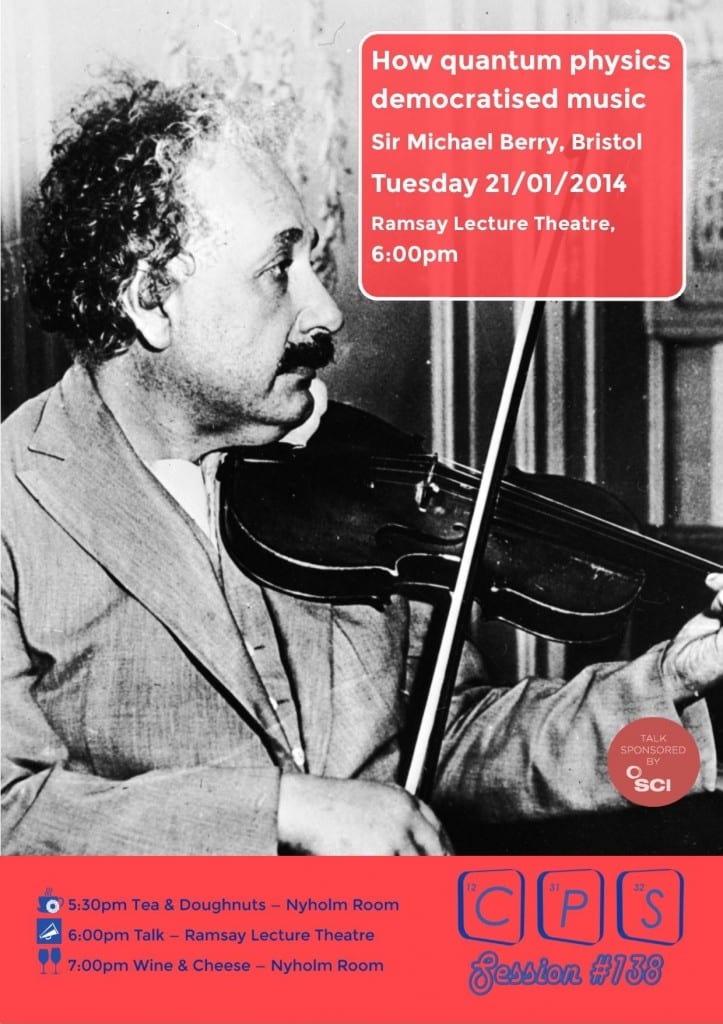Only Connect – CPS Talk 21/01/14
By Penny Carmichael, on 12 February 2014
– Article by Jack Humphrey
“Physics is like sex: sure, it may give some practical results, but that’s not why we do it”
-Richard Feynman
CPS’s second talk of the new term starred Professor Sir Michael Berry from the University of Bristol. His talk explored the interconnectedness between science and technology. Professor Berry’s talk consisted of several examples of physical concepts being used to create new technology that changed the world. But he also spoke of the opposite process, the new science that was being done thanks to advances in technology.
His starting example was the CD player, first introduced in the early 1980s. To read a compact disc you need a way of decoding the digital pits and troughs and this is done with a laser, first invented in 1958. The laser itself was based on the ideas of Einstein in 1917. In his paper he defined three different fundamental interactions between light and matter. Photons of light can excite matter, this is absorption. This excited matter can then release a photon whose energy is proportional to the drop in excitation, this is spontaneous emission. What makes a laser possible is stimulated emission, where a photon hits matter that is already excited, releasing two photons. This cascades and eventually forms a coherent beam of light. This can be shone on a compact disc and detected. The digital signal is then converted into an analogue electrical signal and broadcast. The point of this all being that Einstein had no idea that his theoretical concepts would bring about the laser and the engineers that built the laser had no idea that it would be applied to music. These connections were all unexpected!
Photography owes its creation to a wide number of talented people. The photographic negative, where light causes a chemical reaction that can be fixed and then projected, was invented by Fox Talbot. Talbot had the idea when attempting to sketch a picturesque Italian vista. Not particularly talented, he resorted to using a camera lucida, a draughtsman’s device that projected the image on to paper for the unaccomplished artist to trace around. Unimpressed by his efforts, he wished that he could somehow fix the projected image in place. And several years later, after a lot of tinkering, he did. The film camera allowed people to see the entire world from pictures and invented the art of photography, all thanks to chemistry and optics. Of course, modern digital photography owes itself to science too as the ubiquitous charge-coupled devices are an application of Einstein’s photoelectric effect, published in 1905.
Professor Berry has done some interesting research on “Oriental Magic Mirrors”. These are cast and polished ornamental bronze mirrors with a deep pattern cut into the back. The magic comes by how the pattern on the back can be seen by reflecting light from the front of the mirror onto a surface and can be seen as a sharp image independent of the distance. This was discovered to be due to microscopic dips in the mirror due to the casting process of around 400nm. These were simply observed with a digital camera and analysed with commercial software. This is an example of how theorists like Professor Berry can simply do their own research using modern technology. The magic mirror phenomenon is now being used to analyse irregularities in silicon semiconductor manufacture.
 Close
Close



 Subscribe to this blog!
Subscribe to this blog!